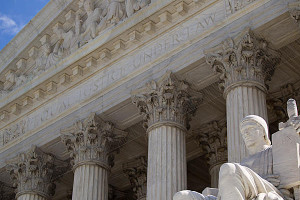by Conrad Imel
 Recently, the General Assembly created a twenty-third judicial district in Colorado. But can the General Assembly just make a new judicial district? Even though the judicial department is a separate branch of the government, the state constitution says it can. In this article we’ll look at the General Assembly’s role in creating and changing judicial districts and the recent change that it made.
Recently, the General Assembly created a twenty-third judicial district in Colorado. But can the General Assembly just make a new judicial district? Even though the judicial department is a separate branch of the government, the state constitution says it can. In this article we’ll look at the General Assembly’s role in creating and changing judicial districts and the recent change that it made.
Judicial districts are responsible for operating district courts within the district.[1] District courts are the courts of general jurisdiction in Colorado. They hear civil cases involving any dollar amount, criminal matters, and domestic relations cases. District courts also hear cases involving probate and minors, such as adoption, dependency and neglect, and juvenile delinquency; except in Denver, which has a separate probate court and juvenile court to handle these cases.
Judicial districts weren’t created by the legislature to administer courts; they are required by the state constitution. Article VI, section 10 of the Colorado Constitution declares that “[t]he state shall be divided into judicial districts” and authorizes the General Assembly to change the number and boundaries of judicial districts with a two-thirds vote of the members of each chamber. Presently, state courts are divided into 22 judicial districts. Some districts contain multiple counties while others consist of a single county. Click here to see a map of Colorado’s judicial districts.
Colorado’s constitution initially provided for four judicial districts with one judge each. Five years later, in 1881, the General Assembly added three new judicial districts, bringing the total number of districts to seven. The General Assembly regularly increased the number of judicial districts over the next 82 years, culminating with the creation of the 22nd Judicial District in 1963. It wouldn’t add another district for nearly 60 years.
In 2020, the General Assembly passed House Bill 20-1026, creating a twenty-third judicial district that will begin operations on January 7, 2025. Currently, the 18th Judicial District consists of Arapahoe, Douglas, Elbert, and Lincoln counties. Beginning in 2025, three of the four counties, Douglas, Elbert, and Lincoln, will leave the 18th Judicial District and become the new 23rd Judicial District, served by eight judges. HB 20-1026 decreases the number of judges in the 18th Judicial District by seven, from 24 to 17. The bill easily satisfied the constitution’s two-thirds vote requirement, receiving just two “no” votes in the House and one in the Senate.
For a legislator, creating a new judicial district isn’t as simple as sponsoring a bill and getting two-thirds of your colleagues to agree to it. The state constitution includes a few requirements for judicial districts and judges that the bill sponsor (and bill drafter!) need to keep in mind. First, article VI, section 13 of the Colorado Constitution requires that each judicial district have an elected district attorney, and section 1-4-204, C.R.S., provides that district attorneys are elected at a general election (held in even-numbered years). Any bill establishing a new judicial district will need to account for a district attorney election and the time it takes the newly elected district attorney to assume the office.
Additionally, the Colorado Constitution requires a district judge to reside in the judicial district in which the judge serves and prohibits abolishing a judge’s office until the end of the judge’s term. A judge may be required to change districts, though, so long as the judge resides in the new district. To comply with these constitutional provisions and ensure that both the new and continuing judicial districts have the proper number of judges who reside in their respective districts, the bill sponsor needs to carefully consider the date the new district will begin operations and account for where the judges of the existing district reside.
It may not happen as often as it used to, but as long as two-thirds of the members agree, the General Assembly can change the state’s judicial districts. Even if the legislature waits another 50 years to do it again, it will need to be mindful of when the new district begins operations to avoid any constitutional issues.
[1] Judicial districts also operate county courts, except for Denver County Court, which is operated by the City and County of Denver and is, in effect, a combined municipal and county court.
